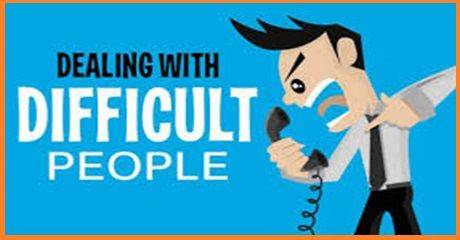Correcting Misbehavior: Strategies for Dealing with Difficult Individuals
Strategies for Dealing with Difficult Individuals, in every society, workplace, or community, encounters with difficult or misbehaving individuals are inevitable. Whether it’s a coworker who constantly undermines team efforts, a student who disrupts classroom activities, or a neighbor who consistently violates community norms, managing and correcting such behavior is crucial for maintaining harmony and productivity. This article explores effective strategies for addressing and correcting misbehavior in various contexts, drawing on psychological insights and practical approaches.

Understanding Misbehavior
Misbehavior can manifest in diverse forms, ranging from subtle passive-aggressive actions to overtly disruptive behavior. The underlying causes are often complex and multifaceted, influenced by individual traits, environmental factors, and social dynamics. Some common types of misbehavior include:
- Disruptive Behavior: Actions that interrupt or hinder normal activities, such as talking loudly in a quiet environment or causing distractions during meetings.
- Defiance: Refusal to comply with rules or authority, challenging norms or instructions deliberately.
- Passive Aggression: Indirect expressions of hostility or resistance, such as sulking, procrastination, or backhanded compliments.
- Boundary Violations: Crossing personal or professional boundaries, which can include invading privacy or making unwelcome advances.
Strategies for Correcting Misbehavior
1. Addressing Misbehavior Proactively
Prevention is often better than cure. By creating a positive and supportive environment, many instances of misbehavior can be preempted. Here are proactive measures:
- Clear Expectations: Establish and communicate clear guidelines, rules, and expectations regarding behavior and conduct.
- Positive Reinforcement: Acknowledge and reward positive behavior to reinforce desired actions.
- Conflict Resolution Training: Provide training in conflict management and communication skills to empower individuals to resolve issues constructively.
2. Immediate Responses to Misbehavior
When misbehavior occurs, addressing it promptly and effectively is crucial to prevent escalation and maintain order. Here are effective strategies:
- Direct Communication: Address the behavior directly but tactfully. Use “I” statements to express the impact of the behavior (e.g., “I feel uncomfortable when…”).
- Active Listening: Hear out the individual’s perspective to understand underlying motivations or grievances.
- Setting Boundaries: Clearly restate boundaries and expectations, emphasizing the consequences of continued misbehavior.
3. Corrective Interventions
For persistent or severe misbehavior, more structured interventions may be necessary:
- Mediation: Facilitate a mediated discussion between parties involved to resolve conflicts and reach mutual understanding.
- Progressive Discipline: Implement a series of escalating consequences for repeated misbehavior, starting with warnings and progressing to more severe measures if necessary.
- Counseling or Coaching: Offer individual counseling or coaching to address underlying issues contributing to the misbehavior.
4. Promoting Accountability and Ownership
Encouraging individuals to take responsibility for their actions and their impact on others is essential:
- Restorative Practices: Foster accountability and repair relationships through restorative justice principles, encouraging offenders to make amends.
- Ownership of Consequences: Help individuals understand the consequences of their actions on themselves and others, fostering empathy and self-awareness.
Case Studies and Practical Examples
To illustrate these strategies in action, consider the following scenarios:
- Workplace Conflict: Resolving a conflict between coworkers through facilitated dialogue and conflict resolution training.
- Classroom Management: Addressing disruptive behavior in a classroom setting with clear rules, positive reinforcement, and counseling for students.
- Community Disputes: Mediating a neighborhood dispute over noise complaints or property boundaries, emphasizing mutual respect and understanding.
Conclusion
Correcting misbehavior requires a nuanced approach that balances assertiveness with empathy and respect. By understanding the underlying causes of misbehavior and employing proactive, immediate, and corrective strategies effectively, individuals and organizations can foster a culture of accountability, mutual respect, and productivity. Each context may require tailored interventions, but the principles of clear communication, setting boundaries, and promoting accountability remain universal. Ultimately, by investing in constructive conflict resolution and behavioral management strategies, we can create environments where individuals can thrive and collaborate effectively despite occasional challenges of misbehavior.

I want forgathering useful info, this post has got me even more info! .
gaw3i8
Make mornings more adorable with this Hello Kitty alarm clock CD player. Ideal for kids and collectors alike, this charming CD clock radio includes all the basics: AM/FM radio, programmable CD playback, and reliable alarm settings. Wake up to your favorite CD or a cheerful radio station with built-in stereo sound. A large digital display and simple controls make it easy to use, even for younger users. Combining cuteness with functionality, it’s a top pick among themed alarm clocks with CD players that bring fun and joy to your space.
You really make it appear really easy together with your presentation but I to find this matter to be actually something that I feel I’d by no means understand. It sort of feels too complicated and very wide for me. I’m taking a look ahead on your next post, I’ll attempt to get the cling of it!
After all, what a great site and informative posts, I will upload inbound link – bookmark this web site? Regards, Reader.
I love your blog.. very nice colors & theme. Did you create this website yourself? Plz reply back as I’m looking to create my own blog and would like to know wheere u got this from. thanks
Hey! I simply want to give a huge thumbs up for the good data you might have here on this post. I will be coming back to your weblog for extra soon.
I will right away take hold of your rss as I can’t in finding your e-mail subscription link or newsletter service. Do you’ve any? Kindly let me understand so that I could subscribe. Thanks.
I think this is one of the most important info for me. And i am glad reading your article. But wanna remark on few general things, The web site style is ideal, the articles is really nice : D. Good job, cheers
I like this site very much, Its a rattling nice post to read and find info . “The absence of war is not peace.” by Harry S Truman.
Good write-up, I am regular visitor of one?¦s site, maintain up the excellent operate, and It’s going to be a regular visitor for a long time.
Hi there! This post couldn’t be written any better! Reading through this post reminds me of my previous room mate! He always kept talking about this. I will forward this article to him. Pretty sure he will have a good read. Thank you for sharing!
you’ve gotten an awesome blog right here! would you wish to make some invite posts on my blog?
Would love to forever get updated outstanding web blog! .
I really like your writing style, wonderful information, thanks for posting :D. “I hate mankind, for I think myself one of the best of them, and I know how bad I am.” by Joseph Baretti.
Great – I should certainly pronounce, impressed with your web site. I had no trouble navigating through all the tabs as well as related info ended up being truly easy to do to access. I recently found what I hoped for before you know it in the least. Reasonably unusual. Is likely to appreciate it for those who add forums or anything, site theme . a tones way for your customer to communicate. Excellent task.
Really insightful post — Your article is very clearly written, i enjoyed reading it, can i ask you a question? you can also checkout this newbies in classied. iswap24.com. thank you
Impressive write-up
I would like to thnkx for the efforts you have put in writing this blog. I am hoping the same high-grade web site post from you in the upcoming as well. Actually your creative writing skills has inspired me to get my own site now. Really the blogging is spreading its wings quickly. Your write up is a great example of it.